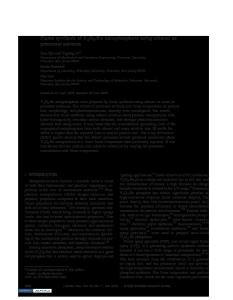Green Synthesis of Y 2 O 3 :Eu 3+ Nanocrystals for Bioimaging
- PDF / 65,059,958 Bytes
- 6 Pages / 612 x 792 pts (letter) Page_size
- 77 Downloads / 367 Views
Green Synthesis of Y2O3:Eu3+ Nanocrystals for Bioimaging Adrine Malek Khachatourian1,2, Farhad Golestani-Fard2, Hossein Sarpoolaky2, Carmen Vogt3, Yichen Zhao1, Muhammet S. Toprak1. 1 Department of Materials and Nano Physics, KTH-Royal Institute of Technology, SE 16440 Kista-Stockholm, Sweden. 2 School of Metallurgy and Materials Engineering, IUST-Iran University of Science and Technology, 16846 Tehran, Iran. 3 Department of Biomedical and X-ray Physics, KTH-Royal Institute of Technology, 10044 Stockholm, Sweden. ABSTRACT Rare earth (e.g., Eu, Er, Yb, Tm) doped Y2O3 nanocrystals are promising fluorescent bioimaging agents which can overcome well known problems of currently used organic dyes like photobleaching, phototoxicity, and light scattering. Furthermore, the alternative quantum dots (QDs) composed of heavy metals (e.g., CdSe) possess inherently low biocompatibility due to the heavy metal content. In the present work, monodisperse spherical Y2O3:Eu3+ nanocrystals were successfully synthesized by microwave assisted urea precipitation method followed by thermochemical treatment. This is a green, fast and reproducible synthesis method, which is surfactant and hazardous precursors free. The as prepared particles were non-aggregated, spherical particles with a narrow size distribution. The calcined particles have a polycrystalline structure preserving the monodispersity and the spherical morphology of the as prepared particles. After calcination of Y(OH)CO3:Eu3+ precursors at 900°C for 2 hours, a highly crystalline cubic Y2O3 structure was obtained. The Y2O3:Eu3+ spherical particles showed a strong red emission peak at 613nm due to the 5D0–7F2 forced electric dipole transition of Eu3+ ions under UV excitation (235 nm) as revealed by the photoluminescence analysis (PL). The effect of reaction time on size and photoluminescence properties of calcined particles and also the effect of reaction temperature and pressure on the size and the yield of the precipitation process have been studied. The intense red fluorescent emission, excellent stability and potential low toxicity make these QDs promising for applications in bio-related areas such as fluorescence cell imaging or fluorescence bio labels. INTRODUCTION Rare earth doped nanocrystalline Y2O3 luminescent materials have attracted interest for applications in display and lightening devices due to high luminescence quantum efficiency, superior chemical stability and color purity [1–3]. For these purposes a wide variety of colors is generated by doping different lanthanide ions in Y2O3 host matrix such as Eu3+ for red, Tb3+ for green, Tm3+ for blue and Dy3+ for yellow emission wavelengths [4]. Each dopant element has fixed and particle size independent emission wavelengths [5], the “caged atoms” in the host matrix create their own atomic levels within the band gap of the Y2O3 host material [6]. Recently these materials have attracted attention because of their potential applications in biomolecular detection, medical diagnostics, bio labels and bio imaging probes [5,7–1











